

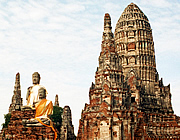
While based in Bangkok we made several excursions outside the city. One of these was to the ancient capital of Ayutthaya .

Ayutthaya was the ancient capital of Thailand from 1350 to 1767. It is named for the home of Rama, Ayodhya, and its full name is "Phra Nakhon Si Ayutthaya - Sacred City of Ayodhya. Ayodhya is Sanskrit for "unassailable" or "undefeatable". 33 kings reigned before the city was taken by the Burmese at which time the city's population was around one million. Many of the sacred sites were destroyed by the Burmese at this time.
It was a golden period for Thailand, when its influence and trading associations were widespread and it ruled a large territory.
It lies some 85 km north of Bangkok and took an hour or so to get to the site of the ruined palaces and temples, some very reminiscent of Angkor Wat in shape. The city is built on an island where three rivers meet - the Chao Praya, the Pa Sak and the Lopburi - and is surrounded by canals.
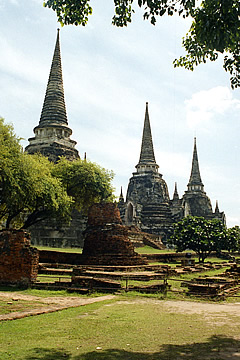
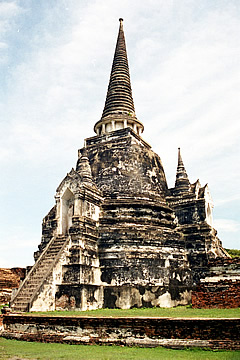

Built by King Boromatrailokanat in 1448 this is a well-preserved temple, the largest on the island. The three chedis are typical Ayutthaya in style, compared to the Khmer-style prangs seen elsewhere. It once housed a 16m Buddha statue, covered in gold, which was destroyed by the Burmese invaders.

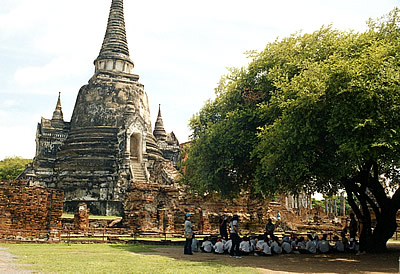
Ayutthaya is really atmospheric to wander around. As with many of the historical sites we visited, there were lots of school children learning about their country's past - mostly very sensibly in the shade of the huge trees in the well-kept grounds of the temple.

This monastery lies just south of Wat Phra Si Sanphet and houses one of Thailand's largest Buddha statues.
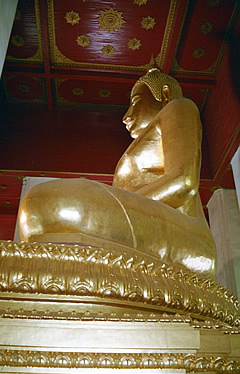
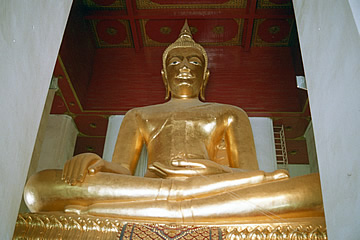
At least early 16th century in origin, the statue has been restored after damage due to lightning and then fire during the Burmese attacks.
The building (viharn) which now houses the statue was built in 1956 and the bronze Buddha was covered in gold leaf in 1990.
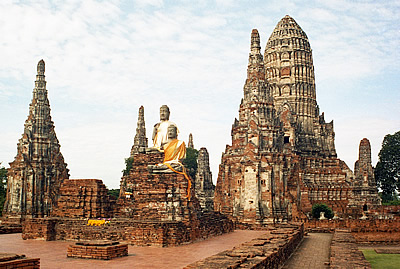
Not actually on the island of ayutthaya but just across the river on the river bank, is this Buddhist monastery, built in 1629 by King Prasat Tong. It is an extremely impressive site with a 35m central Khmer-style prang set in a courtyard with a lesser prang at each corner and other smaller prangs around. In front of the main prang the remains of the Ubosoth - the coronation hall - support two beautiful Buddha statues.
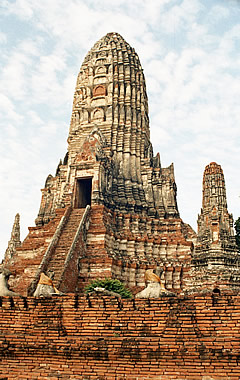
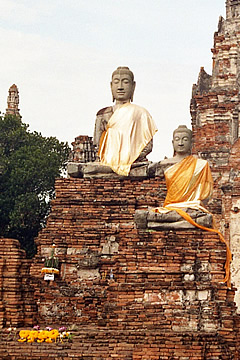
Seated torsos are all that remain of rows of many once-gilded Buddha statues along the courtyard walls.
It's a very tranquil spot now, but still imposing and must have been immensely awe-inspiring in its day.
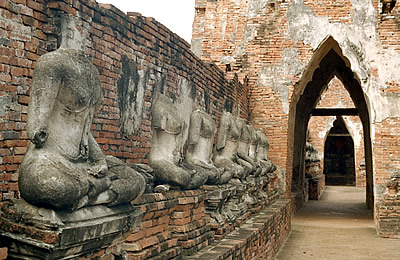
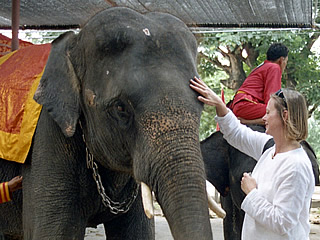
This wooden stockade near Ayutthaya is a restoration of the kraal once used to gather wild elephants.
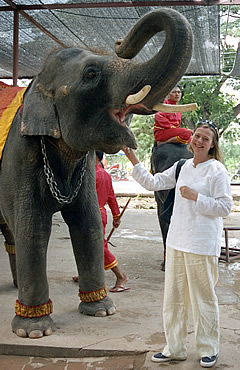
The fence is composed of huge teak logs at a 45 degree angle and the elephants were rounded up and herded into the enclosure. It must have been quite a sight - I don't suppose the elephants would have been too happy about it. There was a raised pavilion from where the king could watch in safety.
For a tip the mahouts will get their elephants to perform tricks - I hate this kind of thing. They thought I was mad when I handed over money but stopped them making the elephants perform! All I wanted to do was get close to them and stroke them.
The elephants look fine but are swaying, which I always associate with boredom and stress.
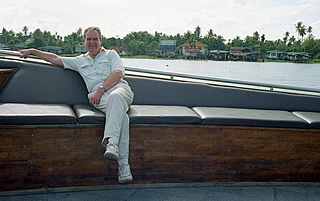
Update 2009 In 2005 the Prakochaban Foundation was set up to help protect Thai elephants. Elephantstay, operating under the foundation, is a programme at the kraal whereby visitors can stay and look after one of the elephants - from the accounts that I've read on the web, visitors become extremely attached to "their" elephant - I can well-understand it.
We returned to Bangkok by boat - a very relaxing four hours with a surprisingly good meal!
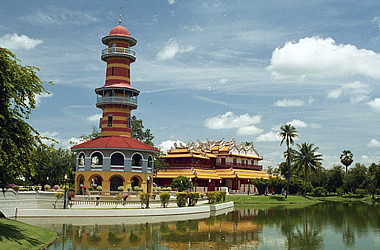
According to the guide leaflet for the palace, a 17th century Dutch merchant, Jeremias van Vliet, reported that King Ekathotsarat (reigned 1606 - 1610/11) was shipwrecked on Bang Pa-In island and there had a son by a woman who befriended him. The son grew up to become First Minister, and after usurping the throne, became King Prasat Thong (reigned 1629-1656). He founded a monastery on land on the island which belonged to his mother, then built a palace to the south of the monastery.
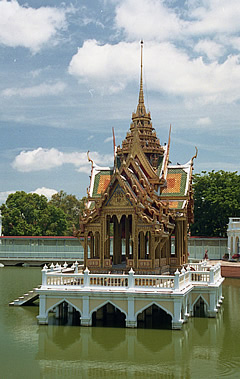
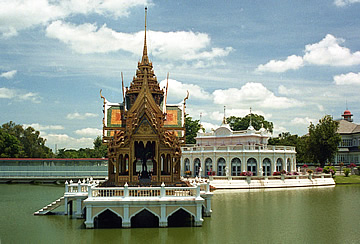
By the beginning of the 19th century the palace was much neglected and only when King Mongkut (Rama IV) ascended the throne in 1851 did attention return to the site. Most of the buildings to be seen now were constructed between 1872 and 1910 during the reign of King Chulalongkorn (Rama V).
The palace is divided by a pond into two parts: an inner palace for the king and members of his family, and an outer palace for the public.
The palace lies about 60 km north of Bangkok. It has a variety of buildings in different styles and in pristine condition. It was extremely hot when we visited and, as most of the buildings are not open to the public, we tended to view the site from the most convenient place in shade!
A beautiful Thai pavilion, in the centre of a large pool, built by King Chulalongkorn, has the daunting name Phra Thinang Aisawan Thiphya-Art - The Royal Residence of the Divine Seat of Personal Freedom. It is a copy of a pavilion built by his father, King Mongkut.
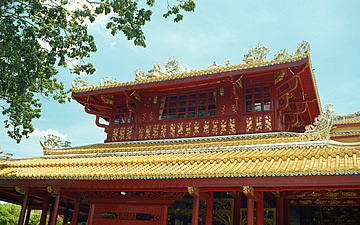
Phra Thinang (Royal Residence) Wehat Chamrun is a Chinese style building in red and gold - Wehat Chamrun means Heavenly Light. It was built by the equivalent of the Chinese Chamber of Commerce and presented to King Chulalongkorn in 1889. A functioning building, it was used as a royal residence when the king visited and it is open to the public.
One of the more curious buildings is the Withun Thatsana - built in the shape of a lighthouse with balconies to give wide views of the palace and gardens.
King Chulalongkorn was apparently fond of gardening and the grounds are still very well-looked after - particularly liked the fine herd of topiary elephants!
